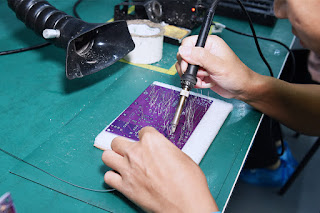Through-Hole Assembly
Through-hole technology (also spelled "thru-hole"), refers to the mounting scheme used for electronic components that involve the use of leads on the components that are inserted into holes drilled in printed circuit boards (PCB) and soldered to pads on the opposite side either by the manual assembly (hand placement) or by the use of automated insertion mount machines.
The quality of the solder joint is important for several reasons. The solder joint is the actual connection between the component and the board. The quality of the solder joint is equivalent to the quality of the connection. The "look" of the solder joint is less important but is usually indicative of the quality of the solder joint.
Through-hole assembly in PCBWay Factory
Characteristics
While through-hole mounting provides strong mechanical bonds when compared to SMT techniques, the additional drilling required makes the boards more expensive to produce. They also limit the available routing area for signal traces on layers immediately below the top layer on multilayer boards since the holes must pass through all layers to the opposite side. To that end, through-hole mounting techniques are now usually reserved for bulkier or heavier components such as electrolytic capacitors or semiconductors in larger packages such as the TO-220 that require the additional mounting strength, or for components such as plug connectors or electromechanical relays that require great strength in support.
Design engineers often prefer the larger through-hole rather than surface mount parts when prototyping, because they can be easily used with breadboard sockets. However, high-speed or high-frequency designs may require SMT technology to minimize stray inductance and capacitance in wire leads, which would impair circuit function. Ultra-compact designs may also dictate SMT construction, even in the prototype phase of design.
Steps in soldering a thru-hole component
Figures 1-1 through 1-4 display the general steps in soldering a thru-hole component. In step 1, the hole and pad to be soldered are prepared, with the lead being placed into/through the hole. The lead should be placed in such a way as to keep the bend above the soldered area, reducing heat and solder requirements.
Figure 1-1. Hole and pad to be soldered—step 1
In step 2, heat is applied evenly to the lead and the pad/hole, heating the material so the solder will adhere to both surfaces.
Figure 1-2. Applying heat evenly to the lead and the pad/hole—step 2
In step 3, the solder contacts the end of the iron, which causes the solder to change into a liquid and flow into the hole.
Figure 1-3. Contacting the end of the iron—step 3.
In step 4, the solder flows through the hole, creating a mound on both the bottom and topside. Since this lead was soldered from the topside, the bottom side should be inspected for adequate solder and joint quality. Some assembly may require solder from both sides to ensure quality. Adequate clearance inside the hole allows good solder flow through the board, allowing only one side to have solder applied. Tight clearances may require soldering on both sides, increasing soldering time.
Figure 3-4. Soldering a lead—step 4





Comments
Post a Comment